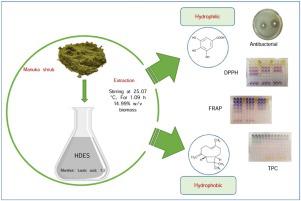Chemical Engineering Research and Design ( IF 3.9 ) Pub Date : 2021-08-09 , DOI: 10.1016/j.cherd.2021.08.004 Noor Alsaud 1 , Kaveh Shahbaz 1 , Mohammed Farid 1

|
Manuka (Leptospermum scoparium) has been studied as a valuable shrub as its leaves are rich in bioactive components such as β-caryophyllene. This study investigated the extractability of hydrophobic deep eutectic solvent (HDES) namely menthol:lactic acid HDES for the total phenolic content (TPC) and antioxidant activity from β-caryophyllene-rich Manuka leaves. Results were also compared with ethanol and n-hexane extracts. The ethanolic extract possessed the highest amount of TPC (86.08 ± 6.22 mg GAE/g DW) among tested extracts. The extraction of TPC using HDES was at a sufficient level (79.82 ± 0.75 mg GAE/g DW), while n-hexane presented poor yield (2.74 ± 0.70 mg GAE/g DW). Higher 2,2-diphenyl-1-picrylhydrazyl radical scavenging activity and ferric reducing antioxidant power were found to be in ethanolic extract. The antibacterial effects of Manuka extract obtained by HDES was also assessed and the results were compared with the antibacterial effect of HDES, lactic acid, commercial Manuka essential oil, steam distilled Manuka oil, and β-caryophyllene pure oil. E. coli, Pseudomonas aeruginosa and Staphylococcus epidermidis were tested using agar disc diffusion method. Results revealed that lactic acid, HDES, and Manuka-HDES extract showed toxicity towards the tested bacteria indicating that the bactericidal effect of the Manuka extract was due to the lactic acid as a forming compound. This study verified the possibility of extracting and characterising different bioactive compounds from Manuka leaves using menthol:lactic acid HDES in a single step and thus it could be explored for broader industrial applications.
中文翻译:

疏水性低共熔溶剂提取的麦卢卡叶(Leptospermum scoparium)的抗氧化和抗菌评价
麦卢卡(Leptospermum scoparium)已被研究为一种有价值的灌木,因为它的叶子富含生物活性成分,如 β-石竹烯。本研究调查了疏水性低共熔溶剂 (HDES) 即薄荷醇:乳酸 HDES 的可萃取性,以测定富含 β-石竹烯的麦卢卡树叶的总酚含量 (TPC) 和抗氧化活性。结果也用乙醇和相比Ñ正己烷提取物。在测试的提取物中,乙醇提取物具有最高量的 TPC (86.08 ± 6.22 mg GAE/g DW)。使用 HDES 提取 TPC 的水平足够高 (79.82 ± 0.75 mg GAE/g DW),而n-己烷的收率很低(2.74 ± 0.70 mg GAE/g DW)。乙醇提取物中发现了更高的 2,2-二苯基-1-picrylhydrazyl 自由基清除活性和铁还原抗氧化能力。还评估了通过HDES获得的麦卢卡提取物的抗菌作用,并将结果与HDES、乳酸、市售麦卢卡精油、蒸汽蒸馏麦卢卡油和β-石竹烯纯油的抗菌作用进行了比较。大肠杆菌、铜绿假单胞菌和表皮葡萄球菌使用琼脂盘扩散法进行测试。结果表明,乳酸、HDES 和麦卢卡-HDES 提取物对测试细菌显示出毒性,表明麦卢卡提取物的杀菌作用是由于乳酸作为形成化合物。该研究验证了使用薄荷醇:乳酸 HDES 一步从麦卢卡树叶中提取和表征不同生物活性化合物的可能性,因此可以探索更广泛的工业应用。


























 京公网安备 11010802027423号
京公网安备 11010802027423号